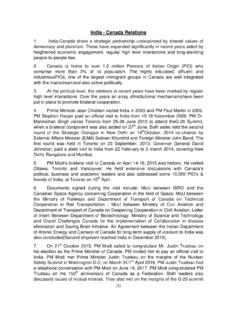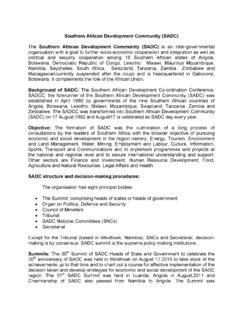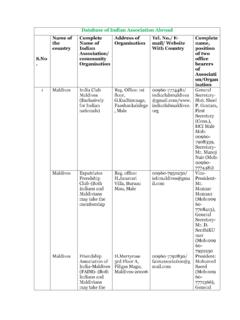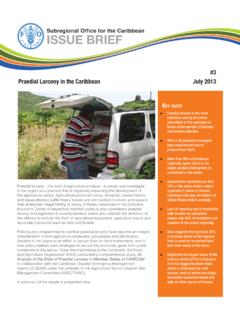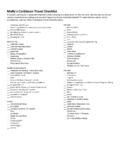Transcription of Caribbean Community (CARICOM)
1 Caribbean Community (CARICOM) In 1972, Commonwealth Caribbean leaders at the Seventh Heads of Government Conference decided to transform the Caribbean Free Trade Association (CARIFTA) into a Common Market and establish the Caribbean Community , of which the Common Market would be an integral part. On 4th July 1973, they signed the Treaty of Chaguaramas establishing the Caribbean Community in Trinidad & Tobago. CARICOM has 15 members Antigua and Barbuda, Bahamas, Barbados, Belize, Dominica, Grenada, Guyana, Haiti, Jamaica, Montserrat, St. Kitts and Nevis, St Lucia, St. Vincent and the Grenadines, Suriname and Trinidad & Tobago. Of the 15, all except Montserrat are nation States. Anguilla, Bermuda, British Virgin Islands, Cayman Islands and Turks & Caicos Islands are Associate Members of the Community .
2 The Chairmanship of the Community is rotated every six months among the member countries Heads with President of Haiti Mr. Michel Joseph Martelly till June 30, 2013. Haiti will host the intersessional meeting of the Conference of Heads of Government of the Caribbean Community (CARICOM) on 18-19 February 2013. Most of the resident and non-resident Ambassadors and High Commissioners accredited to Guyana are also accredited to CARICOM. Between 1993 and 2000, the Inter-Governmental Task Force (IGTF) which was composed of representatives of all Member States, produced nine Protocols, for the purpose of amending the Treaty. These nine Protocols were later combined to create a new version of the Treaty, called formally, The Revised Treaty of Chaguaramas heralding the establishment of the CARICOM Single Market and Economy.
3 The CARICOM Single Market and Economy is intended to benefit the people of the Region by providing more and better opportunities to produce and sell goods and services and to attract investment. It will create one large market among the participating member States. The objectives of the Community , identified in Article 6 of the Revised Treaty, are: to improve standards of living and work; the full employment of labour and other factors of production; accelerated, coordinated and sustained economic development and convergence; expansion of trade and economic relations with third States; enhanced levels of international competitiveness; organization for increased production and productivity; achievement of a greater measure of economic leverage and effectiveness of Member States in dealing with third States, groups of States and entities of any description and the enhanced co-ordination of Member States foreign and foreign economic policies and enhanced functional co-operation.
4 New issues such as e-commerce, government procurement, trade in goods from free zones, free circulation of goods, and the rights contingent on the free movement of persons have been added to CARICOM agenda. The CARICOM Secretariat is the principal administrative organ of the Community and is headed by a Secretary General who is the Chief Executive Officer of the Community . Ambassador Irwin La Rocque of Dominica took over as as new Secretary General on 15 Aug 2011 replacing Sir Edwin Carrigton of Trinidad and Tobago. The international profile of the CARICOM Secretariat has been increasing with its interaction with other countries and international organizations including UN. In recent past a high-level Caribbean forum was held in Trinidad & Tobago on September 4-5, 2012 in which participants expressed confidence that CARICOM countries could recover from the devastating effects of the global financial crisis once they adopt a correct remedial measures.
5 Caribbean Week of Agriculture (CWA) was held in Antigua calling for coordinated efforts to firmly tackle the huge food import bill and ensure food security in the region. Approximately 16 million inhabitants in 15 member states have an annual food import bill of more than US$ 4 billion. The joint Cariforum-EU Council under the Economic Partnership Agreement (EPA) held its second meeting at the EU Headquarters in Brussels. The meeting dwelt on challenges that have arisen in the implementation of the EPA and provide the political guidance with a view to ensure that EPA implementation remain on track. The Conference of Heads of Government is the Supreme Organ of the Community and consists of Heads of States/Governments of all Member States (Chief Minister in case of Montserrat).
6 The Conference determines and provides policy direction for the Community . It is the final authority for conclusion of treaties and entering into relationships with International Organizations and States. 33rd regular meeting of the Conference of Heads of Government of the Caribbean Community was held in St Lucia from 4-6 July, 2012. The Principal Organs of the Community are: (i) Conference of Heads of Government and its Bureau (ii) Community Council of Ministers There have been increasing concerns among member States over the governance structure of the Community and a special committee was formed at the Summit in Jamaica in July 2010 for reform of the structure with the mandate to report at the next session in November 2010. However, no progress on this front was reported to have been made.
7 The Community has five organs and three bodies, viz. (i) Council for Finance and Planning (COFAP) (ii) Council for Foreign and Community Relations (COFCOR) (iii) Council for Human and Social Development (COHSOD) (iv) Council for Trade and Economic Development (COTED) (v) Council of Ministers responsible for National Security & Law Enforcement and (i) Legal Affairs Committee (ii) Budget Committee (iii)Committee of the Central Bank Governors India and CARICOM The High Commissioner of India in Georgetown is accredited as Ambassador to CARICOM headquartered at Georgetown. India established formal relation with CARICOM as a continuation of its diplomatic relations with the individual members of CARICOM. A CARICOM delegation under the leadership of Hon ble Knight, Minister of Foreign Affairs and Trade of Jamaica and the then Chairman of the Community Council, visited India in November 2003.
8 The major outcome of the visit was that an agreement was signed between India and CARICOM Secretariat for establishing a Standing Joint Commission on Consultation, Cooperation and Coordination. The first meeting of India-CARICOM Foreign Ministers was held on 15th February 2005 at Paramaribo (Suriname) on the sidelines of CARICOM Summit. Indian delegation was led by the Minister of State in the Ministry of External Affairs, whereas Foreign Minister of Barbados headed the CARICOM delegation. Possible areas of cooperation identified at this meeting included India s membership of the Caribbean Development Bank (through which India would be able to co-finance development and integration projects in the region), promotion of trade in goods, services and investments with greater Indian participation in Caribbean infrastructure development and regional investment, supply of retroviral drugs for fighting HIV/AIDS.
9 CARICOM has also requested India s contribution to CARICOM Development Fund (CDF) that was established in 2008 to fund economic activities with the CARICOM region. Government of India funded the US$ million information technology and communication infrastructure, computer software and Community studio at the CARICOM Secretariat in 2005-2006. Government of India also provides a few slots annually to CARICOM Secretariat independent of the slots provided to member States for courses in India under the ITEC programme. ** January 2013




